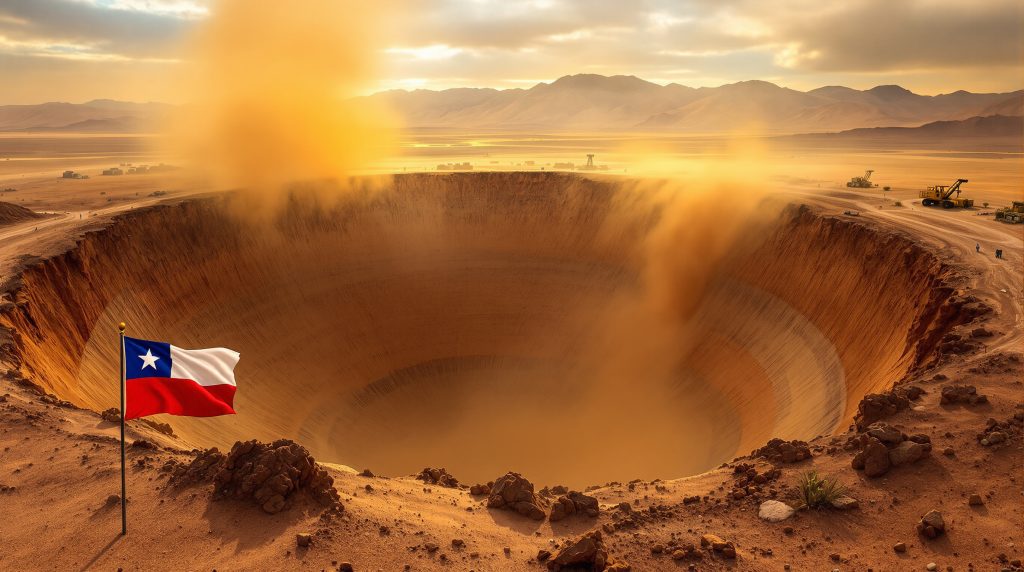What Caused the Massive Sinkhole in Tierra Amarilla, Chile?
The Formation and Discovery of Chile's Mining Disaster
The massive sinkhole that appeared in July 2022 near Tierra Amarilla in Chile's Atacama region wasn't a natural phenomenon but rather the result of extensive mining operations. Environmental court investigations revealed that water drainage from a local aquifer into the Alcaparrosa copper mine gradually weakened surrounding rock structures, creating conditions for geological instability. The cylindrical crater measured approximately 32 meters (105 feet) in diameter when initially discovered, eventually reaching depths of 64 meters (210 feet), creating an imposing void in the arid landscape.
The formation resulted from a combination of hydrological factors and mining practices that didn't adequately account for the region's geological characteristics. When groundwater from the aquifer drained into the mine tunnels, it washed away supporting material, causing the surface to eventually collapse.
Mining Operations and Environmental Negligence
The Alcaparrosa mine, operated by Minera Ojos del Salado (a subsidiary of Canada's Lundin Mining), extracted copper from the resource-rich Atacama region for years before the disaster occurred. Court findings published in September 2025 determined that the mining activities had caused "irreversible" damage to the local aquifer system, a particularly severe impact in a region already suffering from water scarcity.
The environmental negligence stemmed from inadequate protections for groundwater resources during mining operations. By allowing water to drain from the aquifer into the mining tunnels, operators inadvertently triggered a chain reaction that destabilized the underground structures, ultimately causing the catastrophic surface collapse that formed the giant sinkhole in Chilean mining town.
Regional Water Director Rodrigo Saez emphasized the severity of the situation, noting the impact was "detrimental to an area that is already hydrologically stressed," highlighting the compounding nature of water resource damage in the arid Atacama region.
How Has the Sinkhole Affected Local Residents?
Community Fear and Daily Anxiety
"Ever since the sinkhole occurred… we've lived in fear," explained Rudy Alfaro, a resident whose home sits just 800 meters from the crater's edge. This sentiment echoes throughout Tierra Amarilla, where residents have endured three years of uncertainty and psychological stress.
The constant worry about potential expansion of the sinkhole has transformed daily life for local families. Many report difficulty sleeping, hesitation to invest in property improvements, and persistent anxiety about the ground beneath their feet. Children in the community have shown signs of stress-related behavioral changes, according to local reports.
"We were afraid it would get bigger, that it would expand, move toward the houses," Alfaro elaborated, capturing the persistent anxiety felt throughout the community as they watched the unaddressed hazard remain in their midst year after year.
Health and Safety Concerns
Beyond psychological impacts, the sinkhole has created ongoing environmental hazards affecting the physical health of nearby residents. During recent earthquakes, community members reported concerning dust clouds emanating from the crater, raising respiratory health concerns in a population already dealing with the stress of living near such a hazard.
The proximity of essential community facilities to the sinkhole significantly amplifies these concerns. A local health center and preschool are situated dangerously close to the site, placing vulnerable community members at particular risk. The continued presence of the unfilled sinkhole represents both a physical danger and a constant reminder of environmental neglect.
Local health practitioners have noted an increase in respiratory complaints and stress-related ailments since the sinkhole's formation, though comprehensive health studies have yet to be conducted to fully assess the impact on the community.
What Legal Actions Have Been Taken Regarding the Sinkhole?
Environmental Court Ruling and Mine Shutdown
In September 2025, a landmark ruling by a Chilean environmental court ordered Lundin Mining to implement comprehensive remediation measures addressing the damage caused by their mining operations. This decision upheld the January shutdown of the Alcaparrosa mine previously mandated by Chile's environmental regulator.
The court's ruling confirmed the "irreversible" nature of the damage to the regional aquifer system, establishing a legal precedent for environmental accountability in the Chilean mining sector. The decision represents a significant shift toward prioritizing environmental protection and community safety over short-term mining interests.
The shutdown of Alcaparrosa mine marked an important acknowledgment of the severity of the environmental damage, forcing the company to halt operations that had contributed to the catastrophic surface collapse.
Mandated Remediation Requirements
The court's comprehensive decision requires Lundin Mining to implement several critical remediation measures, including:
- Complete refilling of the 64-meter deep sinkhole to restore land stability
- Implementation of protective measures for the region's already stressed water supply
- Addressing long-term environmental damage to the aquifer system
- Developing strategies to prevent similar incidents at other operations
The company publicly committed to "work with authorities to implement remediation measures," though specific timelines and detailed plans remain under development. This ruling represents a significant victory for environmental protection in a region where mining interests have historically taken precedence over ecological concerns.
How Does This Incident Reflect Chile's Mining Industry Challenges?
Water Scarcity in Mining Operations
The sinkhole disaster highlights the critical tension between mining operations and water resources in Chile's arid Atacama region, one of the driest places on Earth. As Regional Water Director Rodrigo Saez noted, the aquifer damage is "detrimental to an area that is already hydrologically stressed," underscoring how mining activities can exacerbate water scarcity in vulnerable ecosystems.
Mining operations in the Atacama typically require substantial water resources for processing ore and controlling dust. This creates an inherent conflict in a region where water is already scarce for agricultural and community needs. The sinkhole incident demonstrates the potentially catastrophic consequences when mining activities interfere with natural groundwater systems in arid environments.
The damage to the aquifer represents a long-term impact that extends beyond the visible sinkhole, potentially affecting water availability for both human communities and ecological systems throughout the region.
Regulatory Oversight and Corporate Responsibility
The three-year gap between the sinkhole's formation in 2022 and the court-ordered remediation in 2025 raises serious questions about regulatory effectiveness in Chile's mining sector. This delay highlights challenges in the country's environmental enforcement mechanisms and the need for more responsive oversight systems.
The case demonstrates the growing expectation for mining companies to take responsibility for environmental impacts throughout the lifecycle of their operations. Lundin Mining's public commitment to implement remediation measures represents an acknowledgment of corporate responsibility, though it came only after court mandates.
This incident has spurred calls for regulatory reform in Chile, with environmental advocates pushing for more stringent pre-approval requirements, enhanced monitoring systems, and faster response protocols when environmental damages occur. Some affected residents have even launched a class action lawsuit seeking compensation for damages.
What Are the Long-Term Implications of the Tierra Amarilla Sinkhole?
Environmental Recovery Timeline
Environmental experts suggest that even with court-mandated remediation, the ecological recovery of the affected area will take decades. The "irreversible" damage to the aquifer system means that water resource management in the region will face persistent challenges, potentially affecting agricultural activities and community water access for generations.
The process of refilling the sinkhole itself presents significant engineering challenges. Specialists must carefully select and layer fill materials to ensure stability while preventing further subsidence. This complex remediation work typically progresses in stages:
- Initial stabilization of the crater walls
- Drainage system installation to prevent water accumulation
- Progressive filling with appropriately graded materials
- Surface restoration and monitoring
Even after physical restoration, the hydrological impacts on the aquifer will continue to require monitoring and management for many years.
Mining Industry Precedents
The Tierra Amarilla case establishes important legal precedents for environmental accountability in Chile's mining sector. Future operations will likely face increased scrutiny regarding:
- Underground stability assessments and continuous monitoring
- Comprehensive hydrological impact studies before approval
- Mandatory community safety buffer zones around operations
- Enhanced emergency response planning requirements
- Long-term environmental monitoring commitments
These precedents extend beyond Chile, potentially influencing mining regulations throughout Latin America and other regions with similar geological conditions or water scarcity issues. Many companies are now investing in sustainable mining practices to prevent similar disasters.
Community Trust and Mining Coexistence
For the residents of Tierra Amarilla, rebuilding trust with the mining industry will require more than just filling a hole. The psychological impact of living with uncertainty for years has created deep community skepticism about mining operations.
Future mining projects in the region will need to demonstrate unprecedented levels of:
- Transparency in operations and environmental monitoring
- Community engagement throughout the project lifecycle
- Rapid response to emerging environmental concerns
- Financial guarantees for remediation if problems occur
- Shared economic benefits that offset environmental risks
This case highlights how mining operations must increasingly balance resource extraction with community welfare and environmental protection to maintain their social license to operate.
What Monitoring Systems Are in Place for the Sinkhole?
Current Safety Measures
Since the sinkhole's formation, authorities have maintained a security perimeter around the crater to prevent accidents and unauthorized access. This physical barrier represents only the most visible aspect of a more comprehensive monitoring approach developed over the three years since the initial collapse.
Ongoing monitoring includes several key components:
- Regular geological stability assessments of the crater walls
- Surveillance of potential expansion or new subsidence
- Correlation analysis between seismic events and structural changes
- Ground penetrating radar studies to detect subsurface voids
- Water level monitoring in surrounding areas
These measures aim to provide early warning of any changes that might indicate further instability or safety risks to the nearby community.
Technology in Sinkhole Management
Advanced monitoring technologies deployed at the site include sophisticated instruments that allow for real-time data collection and analysis:
| Technology | Purpose | Implementation |
|---|---|---|
| Ground-based radar | Detect millimeter-scale ground movements | Continuous monitoring with automated alerts |
| Drone photogrammetry | Create 3D models to track changes in volume and shape | Weekly surveys with comparative analysis |
| Seismic sensors | Correlate earthquake activity with stability changes | Real-time data collection network |
| Hydrological monitors | Track water table changes and movement | Monthly assessments with trend analysis |
| Satellite InSAR | Measure surface deformation over broad areas | Quarterly imaging with historical comparison |
These technologies provide authorities with comprehensive data about the sinkhole's condition, enabling more informed decisions about safety measures and remediation approaches. Advanced 3D geological modelling has been particularly valuable in understanding the subsurface conditions.
How Does This Compare to Other Mining-Related Sinkholes Globally?
Notable Mining Sinkholes Worldwide
The Tierra Amarilla sinkhole, while significant, joins a concerning list of similar incidents in global mining operations:
- Bayou Corne, Louisiana (2012): An 11-hectare sinkhole formed after the collapse of a salt dome mine, forcing the permanent evacuation of an entire community
- Guatemala City (2010): An 18-meter wide, 100-meter deep sinkhole appeared following water infrastructure failures, claiming several lives
- Uralkali Mine, Russia (2014): A 40-meter wide sinkhole formed at a potash mine, causing production losses and environmental damage
- Solikamsk, Russia (2018): A 125-meter wide crater developed above a potash mine after water inflow, threatening nearby infrastructure
Each of these cases shares common factors with the Chilean incident, particularly the role of water infiltration in destabilizing underground mining structures.
Comparative Environmental Impacts
What distinguishes the Chilean case is its proximity to residential areas and critical community infrastructure. While many mining sinkholes occur in remote locations, the Tierra Amarilla sinkhole directly threatens populated areas, including a health center and preschool.
The environmental context also sets this case apart. The damage to the aquifer in the already water-stressed Atacama region represents a particularly severe impact on a fragile ecosystem. Unlike sinkholes in water-rich regions, the loss of groundwater resources in this arid environment has far-reaching consequences for both natural systems and human communities.
The Chilean case also highlights the growing tension between resource extraction and environmental protection in regions facing climate change impacts, where water resources are becoming increasingly precious and contested.
How Can Similar Mining Disasters Be Prevented?
Advanced Geological Assessment Techniques
Modern mining operations can implement enhanced predictive measures to prevent similar disasters:
- Comprehensive pre-mining hydrological modeling to understand water movement
- Regular cavity scanning using ground-penetrating radar during operations
- Continuous microseismic monitoring systems to detect subtle structural changes
- Controlled water management protocols to prevent aquifer drainage
- Proactive ground stabilization in vulnerable areas
These technologies allow mining companies to detect potential problems before they develop into catastrophic failures, enabling preventative interventions.
Regulatory Framework Improvements
The Tierra Amarilla case highlights the need for regulatory reforms in mining regions worldwide:
- Mandatory buffer zones between mining operations and residential areas
- Real-time data sharing requirements for environmental monitoring
- Proactive intervention thresholds before catastrophic failures occur
- Community-inclusive emergency response planning
- Financial guarantees for remediation held in trust before operations begin
These regulatory approaches shift the focus from post-disaster response to prevention and risk mitigation, better protecting communities and environments near mining operations.
Industry Best Practices
Mining companies can adopt preventative approaches that balance resource extraction with environmental protection:
- Implementing controlled collapse mining methods where appropriate
- Developing comprehensive water management systems that protect aquifers
- Establishing transparent community communication channels for early warning
- Creating rapid response remediation funds accessible without legal action
- Investing in research for more mine reclamation innovations
These practices represent a shift toward a more sustainable mining model that acknowledges the industry's responsibility to both the environment and local communities.
What Lessons Can the Global Mining Industry Learn?
Balancing Economic Benefits and Environmental Risks
The Tierra Amarilla sinkhole serves as a powerful reminder that mining operations must balance economic benefits against environmental and community risks. The long-term costs of remediation and community impact can far outweigh short-term production gains from aggressive extraction methods.
This case demonstrates how environmental damages can lead to:
- Significant remediation costs that impact company finances
- Regulatory penalties and operational shutdowns
- Reputational damage affecting investor confidence
- Community opposition to future projects
- Loss of social license to operate in the region
Forward-thinking mining companies are increasingly adopting lifecycle approaches that account for the full environmental and social costs of resource extraction, rather than externalizing these expenses to communities and ecosystems. This approach has led some companies to halt mining projects when environmental risks are deemed too significant.
Community Engagement as Risk Mitigation
Early and transparent community engagement can help identify potential problems before they become disasters. Local knowledge of terrain, historical water patterns, and unusual ground behavior can provide valuable early warning signals that technical monitoring might miss.
Effective community engagement includes:
- Transparent sharing of environmental monitoring data
- Regular community meetings to discuss operations and concerns
- Inclusion of local representatives in oversight committees
- Responsive grievance mechanisms with clear resolution timelines
- Education programs about mining processes and environmental safeguards
When communities are genuine stakeholders in mining operations, they become partners in environmental protection rather than adversaries after damages occur.
Technological Innovation in Safety Systems
The mining industry has an opportunity to develop new technologies specifically designed to prevent subsidence and sinkhole formation. Innovations in backfilling techniques, ground stabilization, and real-time monitoring can significantly reduce risks while allowing resource extraction to continue.
Promising technologies include:
- Automated backfilling systems that maintain ground stability
- Artificial intelligence monitoring that predicts potential failures
- Remote sensing technologies for continuous subsurface assessment
- Sustainable water management systems that protect aquifers
- Ecological restoration techniques integrated with mining operations
These technological innovations represent the future of mining in environmentally sensitive areas, allowing resource extraction with significantly reduced ecological footprints.
FAQs About the Chilean Mining Sinkhole
How long will it take to fill the sinkhole?
Environmental engineers estimate that properly filling the 64-meter deep sinkhole will take 12-18 months, requiring specialized techniques to ensure stability and prevent future subsidence. The process involves multiple stages of material placement, compaction testing, and stability monitoring to ensure long-term safety.
Could this happen in other Chilean mining towns?
Yes, similar geological conditions exist in several Chilean mining regions. Authorities are conducting risk assessments at comparable operations, particularly those with underground mining near aquifer systems. Areas with similar combinations of mining activities, geological formations, and hydrological conditions require special attention and enhanced monitoring.
What compensation have affected residents received?
While the court ruling focuses on environmental remediation, separate civil claims for psychological impact and property devaluation are progressing through the Chilean legal system. Residents are seeking compensation for diminished quality of life, property value losses, and health impacts related to stress and dust exposure.
Has mining resumed at the Alcaparrosa site?
No, the Alcaparrosa mine remains shut down following the environmental regulator's January order, which was upheld by the September 2025 court ruling. The shutdown will remain in effect until remediation measures are completed and authorities determine that operations can resume safely without further environmental damage.
What role did climate change play in the sinkhole formation?
While the primary cause was mining activity, experts note that changing precipitation patterns in the Atacama region may have contributed to altered groundwater dynamics, potentially exacerbating the conditions that led to the collapse. Climate change has increased precipitation variability in traditionally arid regions, creating new challenges for predicting water movement in mining contexts.
Are other mines owned by Lundin Mining being investigated?
Chilean authorities have initiated reviews of safety protocols at all Lundin Mining operations within the country to ensure similar conditions don't exist elsewhere. These reviews include enhanced monitoring requirements and reassessments of hydrological impact studies to prevent comparable incidents at other sites.
Ready to Invest in Companies Focused on Mining Safety?
Discover how advanced mining monitoring technologies and safety systems are transforming the industry with Discovery Alert's proprietary Discovery IQ model, which instantly alerts investors to significant ASX mineral discoveries and emerging opportunities in the mining sector. Explore historic examples of exceptional market returns on the Discovery Alert discoveries page and position yourself ahead of the market.




